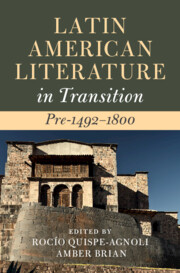Book contents
- Latin American Literature in Transition Pre-1492–1800
- Latin American Literature in Transition
- Latin American Literature in Transition Pre-1492–1800
- Copyright page
- Dedication
- Contents
- Figures
- Contributors
- Acknowledgments
- Introduction Dwelling in Transitions
- Part I Land, Space, Territory
- Part II Body
- Part III Belief Systems
- Part IV Literacies
- Part V Languages
- Chapter 18 Technologies of Communication in Transition: Indigenous Orality and Writing in Colonial Mexico
- Chapter 19 A Baroque Arte: Horacio Carochi and the Tradition of Nahuatl Grammars
- Chapter 20 Acquiring a Voice: The Plebeians Speak in Early Colonial Río de la Plata
- Chapter 21 Knowledge in Transition: Rethinking the Science of Sameness in Sor Juana Inés de la Cruz’s New Spain
- Part VI Identities
- Index
- References
Chapter 18 - Technologies of Communication in Transition: Indigenous Orality and Writing in Colonial Mexico
from Part V - Languages
Published online by Cambridge University Press: 25 November 2022
- Latin American Literature in Transition Pre-1492–1800
- Latin American Literature in Transition
- Latin American Literature in Transition Pre-1492–1800
- Copyright page
- Dedication
- Contents
- Figures
- Contributors
- Acknowledgments
- Introduction Dwelling in Transitions
- Part I Land, Space, Territory
- Part II Body
- Part III Belief Systems
- Part IV Literacies
- Part V Languages
- Chapter 18 Technologies of Communication in Transition: Indigenous Orality and Writing in Colonial Mexico
- Chapter 19 A Baroque Arte: Horacio Carochi and the Tradition of Nahuatl Grammars
- Chapter 20 Acquiring a Voice: The Plebeians Speak in Early Colonial Río de la Plata
- Chapter 21 Knowledge in Transition: Rethinking the Science of Sameness in Sor Juana Inés de la Cruz’s New Spain
- Part VI Identities
- Index
- References
Summary
This essay centers on the dynamic and inherently complex interplay among pre-Hispanic and European languages and writing (in the broadest sense) in New Spain. It addresses the populations, spaces (geographic and institutional), and formats in which theories, policies, and practices of language use and inscription shifted through three centuries of colonial rule. Emphasis is placed on the strategic choices of indigenous subjects, primarily Nahuas, in their sonic and visual communication practices. It pays attention to the violent processes that went hand in hand with the imposition and acquisition of European communicative practices and tools. Through the analysis of a wide variety of textual genres produced by indigenous peoples and Spaniards, some of the questions treated in this essay are: how did the use of Nahuatl, Spanish, or Latin convey prestige, authenticity, and legitimacy in some circumstances, and in others not? In what ways did the Roman alphabet become a powerful tool wielded by native peoples? Why were indigenous painted amoxtli recreated by memory, then glossed with Spanish text, decades and even one hundred years after the zealous priests burned the originals?
Keywords
- Type
- Chapter
- Information
- Latin American Literature in Transition Pre-1492–1800 , pp. 275 - 287Publisher: Cambridge University PressPrint publication year: 2022



